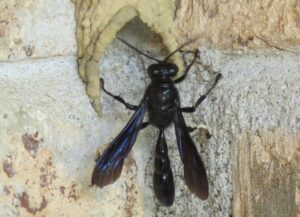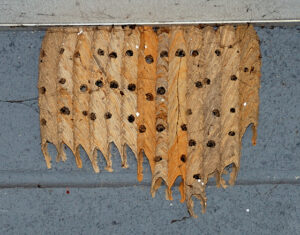Organ Pipe Mud Dauber (Trypoxylon politum)
Updated on
17/11/2022The organ pipe mud dauber is a fairly large predatory wasp of the family Crabronidae. It flies from May to September. Being extremely docile, the wasp is pleasant to have around as it keeps spider populations down. It stings only in self-defense when someone squeezes it. It is larger and more abundant than the other species in its genus.
Scientific Classification
- Class:Insecta
- Order:Hymenoptera
- Family:Crabronidae
- Genus:Trypoxylon
- Species:T. politum
Conservation Status
Description
The size of the wasp ranges from 3.9-5.1 cm. Males and females are both shiny black, with the tip of the back legs pale yellow to white.
Distribution: Southeastern Canada to Eastern United States.
Habitat: The mud nests are built in tree holes or the undersides of bridges. 3 criteria should be fulfilled by a nesting site. They are, a smooth, vertical surface with a lot of shade and rainfall protection, an adjacent forest, and a source of mud nearby.
Do They Bite/Sting: Yes.
Lifespan: 3-6 weeks.
Predators: Tufted titmouse.
Behavior and Characteristics
Diet
They have mainly 3 genera of spiders as food – Neoscona, Eustala, and Araneus.
Nest-building
The nests are built by the females. She can build a new nest, use an abandoned one, challenge another female to take possession of her nest, or (rarely) enter a newly constructed nest and remove its eggs to replace them with her own.
The nests are long mud tubes of multiple cells fortified with paralyzed spiders. On average, a female makes 5-6 pipes in a cluster. The pipes can either be made side by side or one on top of the other. When the pipes are added in layers, the chances of survival of the freshly emerged adults decrease as they have to chew their way out of a pipe for emergence.
Life Cycle
1. Egg Stage
The females lay an egg in each nest cell, after which she leaves.
2. Larva Stage
The larvae hatch out of the eggs and feed on the spiders kept in the nest.
3. Pupa Stage
The larvae pupate till they turn into adults.
4. Adult Stage
A freshly hatched female usually starts building her own nest within 48 hours of leaving the nest she was born in. The offspring can either emerge after winter, before June-end or may overwinter and reproduce after winter. 1-2 generations are produced in a year.
The male stays guard at the nest’s opening to protect the offspring from other males, parasites, and intruders. They may also help the females in nest-building. The males develop from unfertilized eggs and are haploid, while the females are diploid as they develop from fertilized eggs. The mothers allocate more food for the fertilized eggs than the unfertilized resulting in larger females than males.
Source
blogspot.com, bugguide.net, marylandbiodiversity.com












